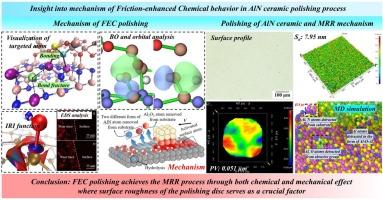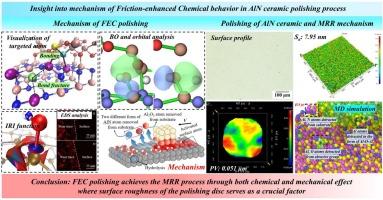AlN陶瓷抛光过程中摩擦增强化学行为机理的研究
IF 6.9
2区 材料科学
Q2 CHEMISTRY, PHYSICAL
引用次数: 0
摘要
氮化铝陶瓷以其优异的导热性而闻名,在电力电子领域得到了广泛的应用,其中表面粗糙度是其性能的关键参数。为了解决抛光效率与表面质量之间的矛盾,提出了摩擦增强化学抛光技术。利用第一性原理法计算了吉布斯自由能,验证了AlN在水环境中的反应性。抛光实验结果表明,经过90 min的抛光后,表面粗糙度Ra达到8.523 nm,材料去除率达到3.3198 μm/h。对比实验表明,摩擦增强化学抛光具有较好的抛光性能。最后,利用分子动力学方法揭示了材料的去除机理。本文章由计算机程序翻译,如有差异,请以英文原文为准。


Insight into mechanism of Friction-enhanced chemical behavior in AlN ceramic polishing process
Aluminum Nitride ceramic, renowned for its exceptional thermal conductivity, has found extensive applications in power electronics, where surface roughness serves as a critical parameter for its performance. This paper proposed the friction-enhanced chemical polishing to address the conflict between efficiency and surface quality. The Gibbs free energy was calculated through First-Principle method to verify the reactivity of AlN in water environment. Polishing experiment results show that the surface roughness Ra reach 8.523 nm and material removal rate reach 3.3198 μm/h after 90 min’s polishing. Comparison experiments were conducted to demonstrate the better performance of the friction-enhanced chemical polishing. Finally, the molecule dynamic was employed to reveal the material removal mechanism.
求助全文
通过发布文献求助,成功后即可免费获取论文全文。
去求助
来源期刊

Applied Surface Science
工程技术-材料科学:膜
CiteScore
12.50
自引率
7.50%
发文量
3393
审稿时长
67 days
期刊介绍:
Applied Surface Science covers topics contributing to a better understanding of surfaces, interfaces, nanostructures and their applications. The journal is concerned with scientific research on the atomic and molecular level of material properties determined with specific surface analytical techniques and/or computational methods, as well as the processing of such structures.
 求助内容:
求助内容: 应助结果提醒方式:
应助结果提醒方式:


